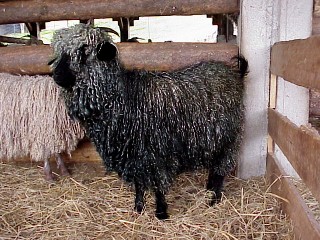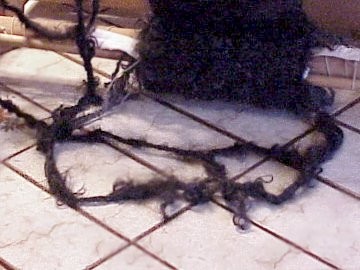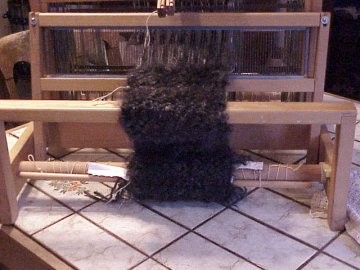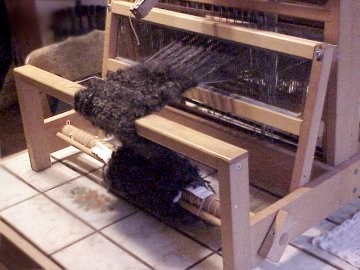~~* Black Sheep Newsletter............Issue 122............Winter 2004 *~~
 †
†
THE HOMESTEAD: Spinning Black Mohair Tailspun and Weaving Black Mohair Scarves
Black seems to be the official color this Holiday season. Five black scarves ordered in the last couple of months! It began with my first customer (a return customer, by the way – my favorite kind!) writing me an e mail in late October.![]()
"I had an epiphany of sorts," she began, first explaining that she had received as a gift a wonderful, warm black wool coat. Now she wished to purchase yet another mohair scarf. (She had one of ours already, a white kid mohair scarf that she loved immensely.) This one would have to match the coat, of course. "It must be black," she stated.![]()
"Surely you have some black kids in the herd?" she queried in her note. Then she added. "And I want another scarf – for my husband, for Christmas. It should be charcoal gray in color." She asked me if I could fill the order.![]()
I told her "no problemo," and then came the day it was time to set my hand to the task. I wished to weave the nicest scarves I could – and for that I needed my very best kid fleeces.![]()
As though it were my own "epiphany," I knew immediately which fleece I wanted to use for the black scarf. It had to be Baraq's fleece, his first clip – a gorgeous clip I had saved for nigh on two years, carefully storing it for a special spinning project that I assumed would be for my own private use.![]()
Choosing the Fleece
Finding the black kid fleece still in the original white bag that it had been kept in, the bag marked "Baraq" with Valentine hearts drawn all around it by my own hand - I opened the bag with remembrance and a bit of nostalgia. He, black fleeced and blue-eyed, was a favorite buck and he'd died before his time when only a yearling. I gazed at the first clip that he'd given us and again reminded myself that I still had his son, the Ace of Spades, a good looking young yearling himself now. Baraq lived on.![]()
I smiled as I pulled a luscious long stapled lock forth from the bag. It felt buttery soft and smooth in my fingers still, like the day it was sheared. The long black lock shone as the sun filtered through the barn loft that late October day. A prettier black fleece would be hard to find on the place, and one as soft would be doubly difficult.![]()
"This is for her black scarf," I said in my mind. "None other will do." Then I began to search my storage containers for a charcoal gray fleece, soft and lustrous.![]()
After some time I decided I wasn't satisfied with anything in that loft to fit the bill for the charcoal gray. I climbed down the ladder that serves as my awkward stair – exited the barn's first story on that wide plank bridge, and went down to the ground floor. The ground floor is where 50 angora goats mill around. "Charcoal gray..." I mused.![]()
Then my eyes spied Zeba, her charcoal gray mohair long and as lustrous as burnished silver. She, a yearling with an ultra-soft fleece, stood there looking spectacular that morning.![]()
"Come here, epiphany," I cajoled, as the little goat ran from me. Within a few moments I somehow caught her (they all run amok when it's time to be caught.) Taking ahold of her horns, I brought her close to me so that I could examine her fleece. Yes, it would be perfect for the second scarf.![]()
At times the question has come my way, "What exactly does it take to weave one of your garments – from start to finish?" I always answer that query with, "It begins first with the shepherd's crook."![]()
Seeing their puzzled look, I explain. "First I must go out into the goat yard. Then I call them all in with a grain can in my hand – they always come to the grain. I look around. Finally I choose the fleece I like in the whole bunch. Then I take my shepherd's crook – and pull that goat close to me. Then I call Stan, the shearer."![]()
Shearing, Washing the Fleece

Fine Black Doe Zeba
So, to begin the task, husband Stan sheared Zeba for me. Her fleece was a full and soft one and the charcoal gray ringlets lay lovely in their bag. She seemed awfully cold, shivering there in the goatyard amidst a bevy of fully clothed goats that stood around her, not quite understanding why she, of all goats, had to be the naked one. I went into the barn loft and found a nice wool sweater that was a garage sale treasure and placed it on her, cutting the sleeves so that they fit over her front legs.![]()
The sweater trailed behind her as she walked, like a bridal train, and she was no longer shivering. The other goats made fun of her and her gown, but she seemed nonplussed by their flagrant comments. I believe she felt rather queenly.![]()
"Two bags full," I said to myself, grabbing up Baraq's baby clip in its bag and Zeba's newly shorn clip in its own encasement. I brought them both inside the house and then began the process of "making a garment from scratch."![]()
Making a Garment from Scratch
First, I began to fill the tub of the washing machine with very hot water. A few squirts of my favorite shampoo for mohair (Dawn dish detergent,) I dropped Baraq's fleece in the washer and let it soak for a long time – or until the water was lukewarm.![]()
Just as with wool, one should never agitate mohair. When it was time to let the water out, I placed the washing cycle on "spin." After two more soakings – a little bit of stirring around with a wooden spoon - and one careful rinse, I spun the water out of his fleece entirely. It was now ready for the next process: drying.![]()
|Ah, yes, drying.

Tailspun Natural Black Mohair
I recalled the last time I attempted to dry some mohair (doll hair that time) in the sunshine that the new puppy had found the whole clean clump and had dragged it all over the yard. When I found her (and it) I was madder than the proverbial hatter. Fuming, I had scolded her and picked up the bedraggled mohair, filled to the brim with autumn leaves and debris, brought it inside the house, threw the mohair on the floor and fought off tears.![]()
Gaining courage, I began to pick through it with tweezers for at least two long hours until I was satisfied that it was ultimately clean again.![]()
I certainly didn't want to go through that again.![]()
So, after putting the aussie pup into her kennel along with a couple of doggie bones, I was able to take my black fleece outside into the mid-November sun. By the end of the day it was dry enough to bring into the house. The pup went outside then, and all was well, no temper tantrums for either of us.![]()
Picking the Fleece
Next comes the process of "picking" the fleece, though I had already predetermined that I would only pick and then card the warp for my scarves. The weft for both scarves would be spun uncarded. (I'll talk about the weft further on.)![]()
My Patrick Greene picker with its iron points will make quick work of tearing up a mohair fleece, especially a kid fleece, if used improperly. My friend in Tucson refuses to pick her kid goat fleeces with her picker. Instead, she takes the fleece lock by lock and handpicks. She says her picker is too rough on the kid mohair and that it "tears" readily.![]()
I have not had that problem. Always, though, I place only small amounts of mohair into the feeder as I swing the picker's attachment with its many iron points on its hinges. Feeding a smaller amount seems to make the difference between separating the fiber into wafting clouds or abusing the fiber. Also, as stated previously, the mohair has got to be scrupulously clean. Only clean fiber will not tear in the picker nor ultimately pill up in the carding machine.![]()
Once I have enough "picked" mohair for the warp of my scarves, I put those clouds of mohair in bags. My husband receives those bags of picked mohair, for he's the guy that cards.![]()
And Finally, the Spin
After he cards the kid fleece, he lays lovely carded batts next to my spinning wheel. I feel a bit queenly at that point. All the fiber has been washed and dried and now lays in lofty well combed piles beckoning to my spinning hands.![]()
I lay a pillow on the chair and pull the wheel close to me. A fire in the Russian furnace warms the room if it's winter in Oregon. If the sun shines brightly, I open lace curtains so that I can see the mountain tops while I spin away in my mountain hideaway.![]()
The piles of carded mohair go quickly and soon are double-ply yarns that are ready for washing. It is high time to spin the weft for my scarves. After deliberating a bit, I have decided to tailspin the weft for both the black and the charcoal gray scarves.![]()
"Tailspinning" takes a bit longer, but I love the look of tailspun yarn and also readily enjoy the technique. It is extremely rustic looking with mohair curls displayed along the entire length of the yarn, a bit exotic, in my opinion.![]()
I don't know how others tailspin their yarns and someday I'll need to find that out, but for me it's a simple process that always begins with the very curliest and softest and CLEANEST fleece. A dirty fleece will not do.![]()
Quite simply I grab up a clean lock from the fleece I'm working with and pull the lock away from the others. Then I carefully spread the lock with my fingers. Here's the important part that might be best explained with a photograph, but I hope to do it justice here with words: turn the mohair lock sideways. Then spin from the center of that sideways lock.![]()
The fact that the lock is held sideways (horizontally) and is not being spun vertically makes all the difference in the spin of the yarn. Experiment and have fun. Tailspinning is nothing short of fun.![]()
There are times I tailspin a thick single ply yarn and sometimes a thin one. No two are alike and all are lovely.![]()

Tailspun on the Loom
Then comes the weaving, of course, the final phase of this age-old task of making something with the fiber grown on animals that roam the pasture, butt each other and at times butt you. All my yarns were spun – both warp and weft yarns, for both scarves.![]()
I decided to weave the black scarf first. The question as to which loom to use was easily solved. I decided to use the 20 inch table loom. When it comes to weaving scarves, table runners, even shawls - I just don't think anything is quite as nice as weaving on a small, compact table loom, a loom I can work with and then move easily into an adjoining room when its time to clean off the table.![]()
Let's start with the warp. Once I have cut the black warp yarn from my warping board (after measuring accurately for my anticipated project and that measuring process is best found out about in books) I always soak my to-be warp yarns in a weak solution of corn starch and water. (I've brought that solution to a boil previously and let it cool before submerging my warp for a couple of minutes in the solution. Let it soak up that corn starch and water and then take it out.) It's then time to let the warp drip dry in the warm sun. (I don't forget to put the pup in her kennel at those times, a bone or two to keep her amused.)![]()
The warp, now dry, is rather stiff and is now strong enough to withstand the strain of the loom. It seems what really takes handspun mohair to task on a loom are all the metal edges – both on the heddles and on the reed. Metal edges will fray mohair. Ever since I've "sized" my warps using this corn starch and water dip, I must say that I no longer fear warping my loom with handspun mohair, even if the spin of my warp yarn is rather fine.![]()
Now, to Weave
The first scarf, the black one, was warped with black kid hair. The weft was tailspun thickly, and therefore, the weaving of the scarf went rather quickly. When completed, the scarf was jet black with some color variegation, silver highlights throughout. Baraq's fleece, though primarily black as coal, had a wee bit of silver at the base of the clip. His adult mohair would eventually turn silver. Thus, the variegation.![]()

Tailspun on the Loom
The black scarf with all its silver highlights was off the loom. I laid it carefully aside and admired it under the high electric light that shines on the big loom in the living room. Electric light on mohair is a feast for the eyes.![]()
I took all of Zeba's yarns and brought them to the table loom next, the charcoal gray yarns that were much lighter in color than the black yarns – almost a silver blue under light. I soaked the warp in sizing, dried the warp, warped the loom. Her soft curly fleece had been tailspun (a finer tailspin than the black yarn) and plied.![]()
After I'd finished the gray scarf, I took both scarves and washed them. All work off the loom should be washed and many say that all work off the loom should also be pressed, though I rarely press my mohair weavings. Mohair seems to iron out nicely on its own, showing so few wrinkles.![]()
Since that week before Thanksgiving in southern Oregon's Cascade mountain range was a week of frivolous sunshine days, both scarves were taken outside to dry. They both looked regal under a cobalt sky, framed by mohair curls that arbitrarily reached past the boundaries of the selvedges.![]()
"Her epiphany, hanging there on my fence drying," I thought to myself, pleased. "From goat to garment..." I gazed at the two lovely scarves dripping water high on a fenceline until my thoughts were reined and came to a sudden halt.![]()
"Here, puppy!" I called. I kenneled her then and gave her two bones to gnaw on and was glad I remembered.![]()
The other three black scarves? Two went out yesterday, all soft black curls, black apparently being the color of Christmas this year. The fifth was just ordered this morning by e mail. "For my girlfriend," he said. "Make sure it's black, soft and fuzzy." Happy Holidays to all of you from Singing Falls![]()
Alexandra Scribe
Homestead Home
TOP






